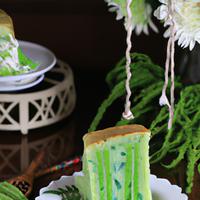
1 serving (100 grams) contains 300 calories, 5.0 grams of protein, 15.0 grams of fat, and 40.0 grams of carbohydrates.

Log this food in SnapCalorie

Nutrition Information
Calories |
721.2 | ||
|---|---|---|---|
% Daily Value* |
|||
| Total Fat | 36.1 g | 46% | |
| Saturated Fat | 12.0 g | 60% | |
| Polyunsaturated Fat | 0 g | ||
| Cholesterol | 120.2 mg | 40% | |
| Sodium | 360.6 mg | 15% | |
| Total Carbohydrates | 96.2 g | 34% | |
| Dietary Fiber | 2.4 g | 8% | |
| Sugars | 60.1 g | ||
| protein | 12.0 g | 24% | |
| Vitamin D | 0 mcg | 0% | |
| Calcium | 72.1 mg | 5% | |
| Iron | 2.4 mg | 13% | |
| Potassium | 240.4 mg | 5% | |
* Percent Daily Values are based on a 2,000 calorie diet. Your daily values may be higher or lower depending on your calorie needs.
Food Attributes
Source of Calories
About Pandan shifon cake
Pandan chiffon cake is a soft, fluffy dessert originating from Southeast Asia, particularly popular in Indonesia, Malaysia, and Singapore. Its vibrant green hue comes from pandan leaves, a tropical plant known for its sweet, floral aroma. Made with a combination of eggs, flour, sugar, coconut milk, and vegetable oil, the cake is light and airy due to the incorporation of whipped egg whites. While pandan chiffon cake is lower in fat compared to butter-based cakes, it is still a treat high in sugar and should be consumed in moderation. Pandan leaves are celebrated for their antioxidant properties, but their nutritional benefit in the cake is minimal due to the diluted concentration. This dessert is a delightful complement to tea or coffee and is often enjoyed during festive occasions or as a simple everyday indulgence.



